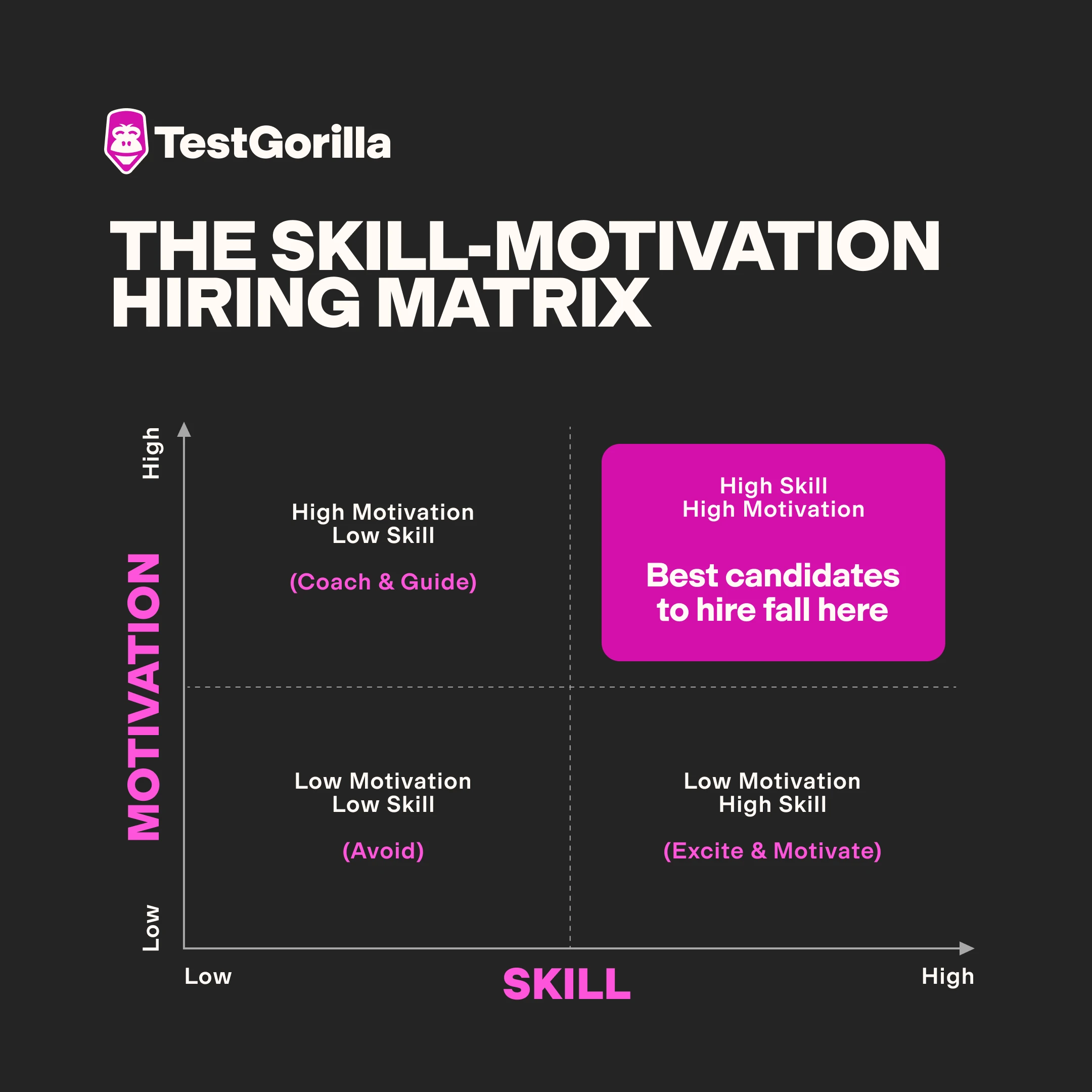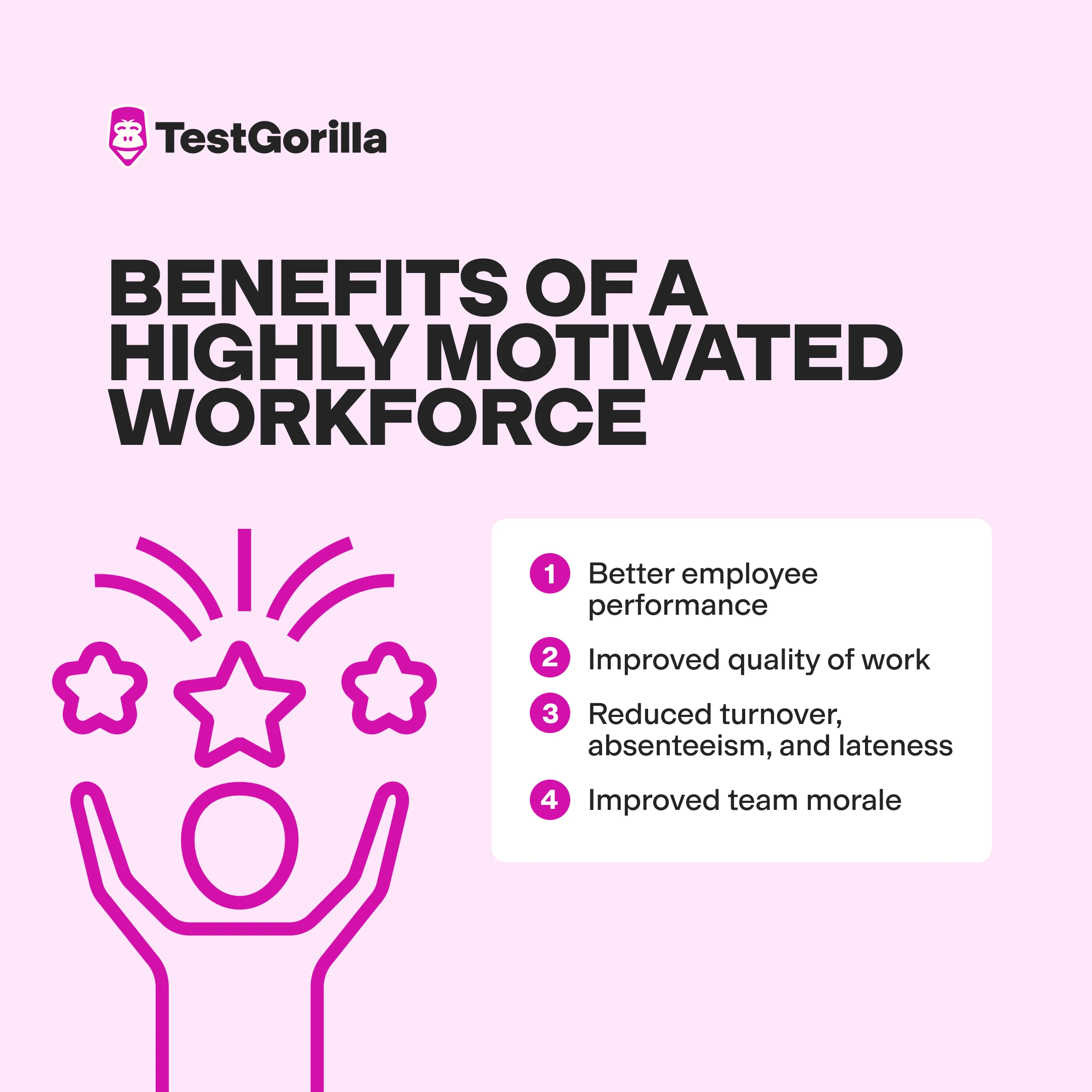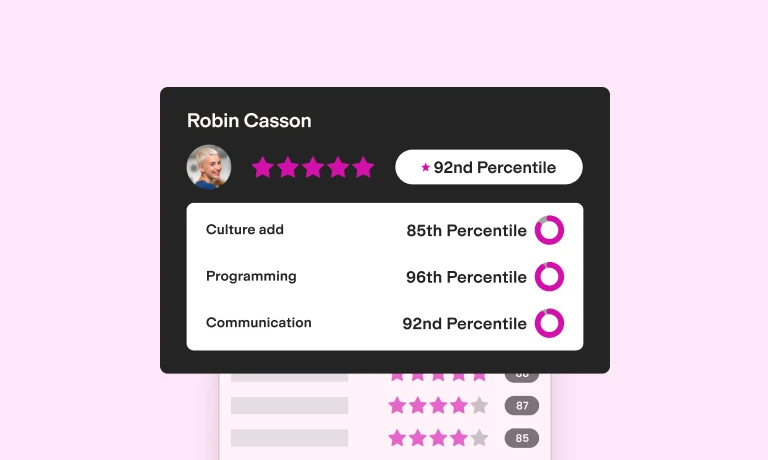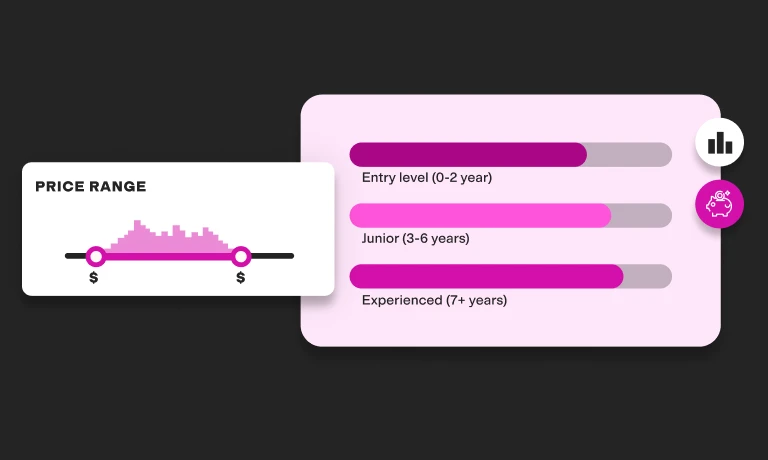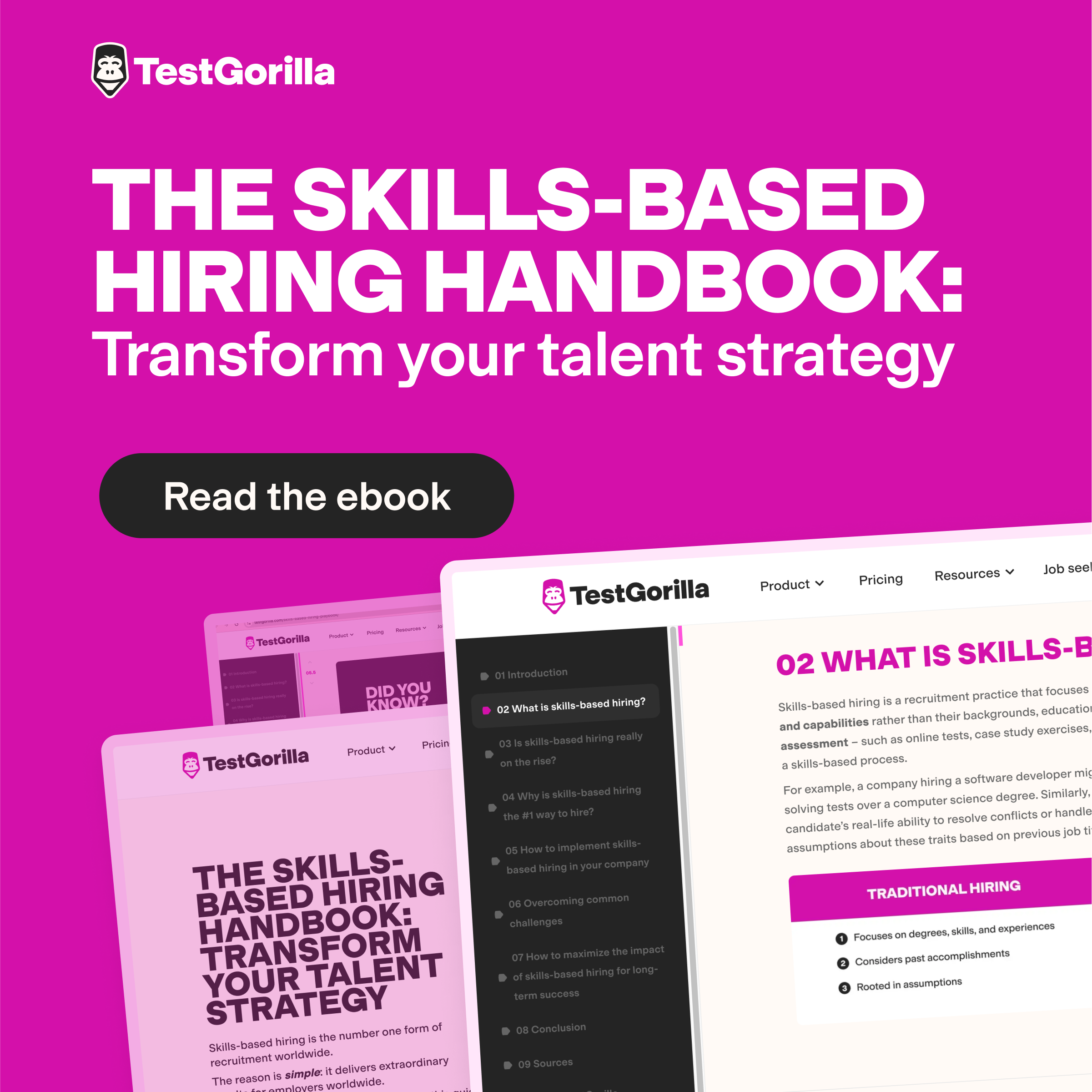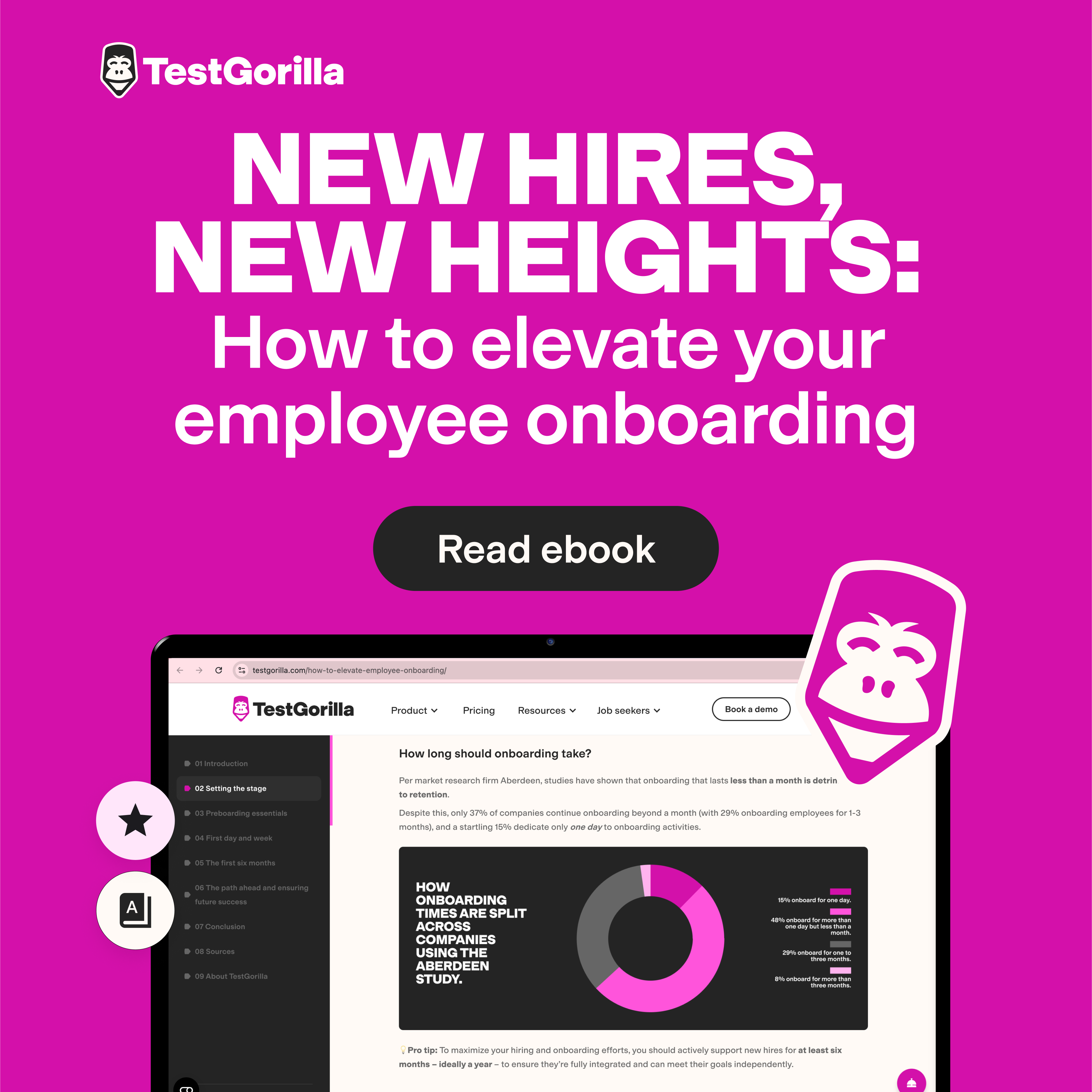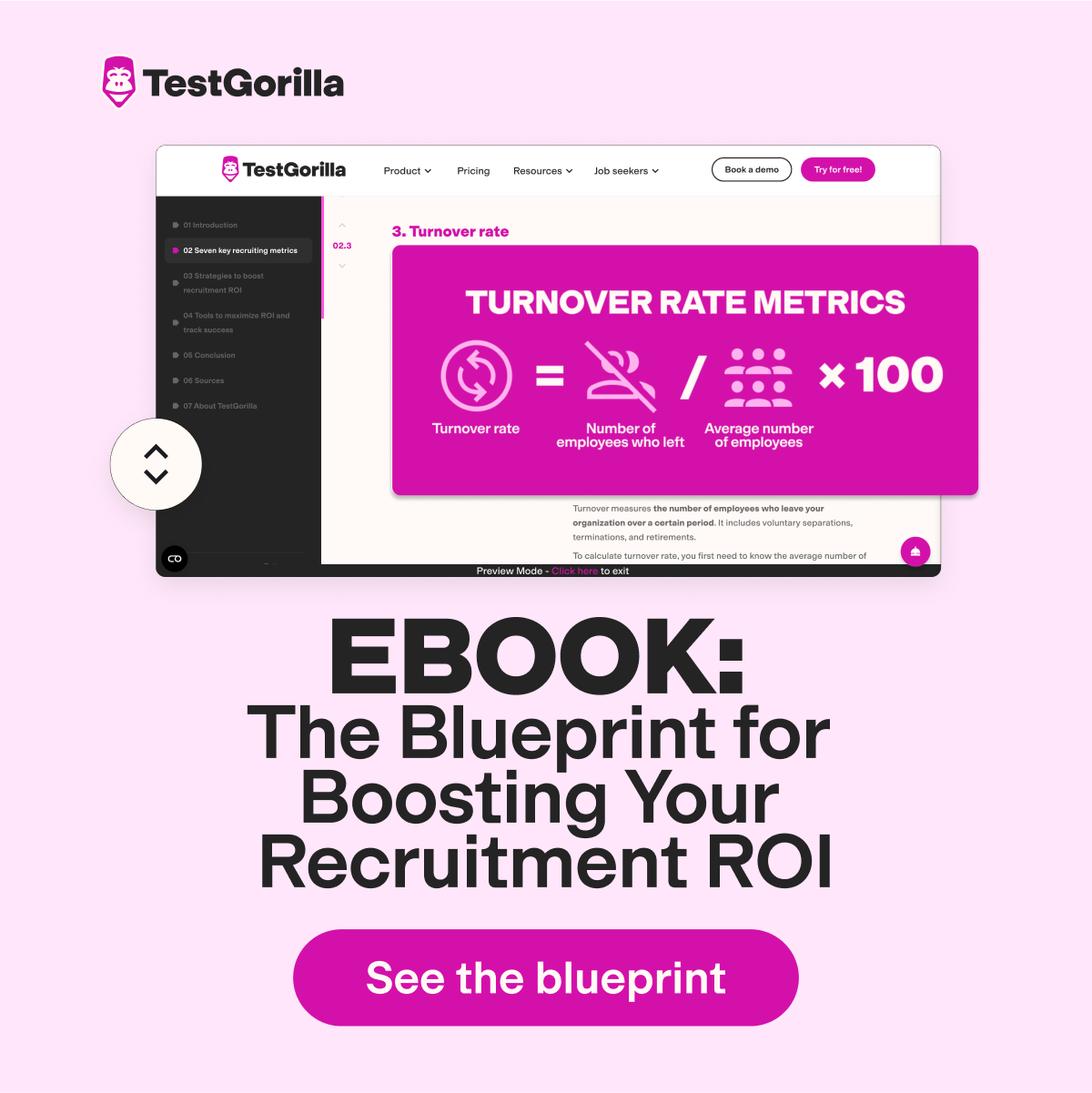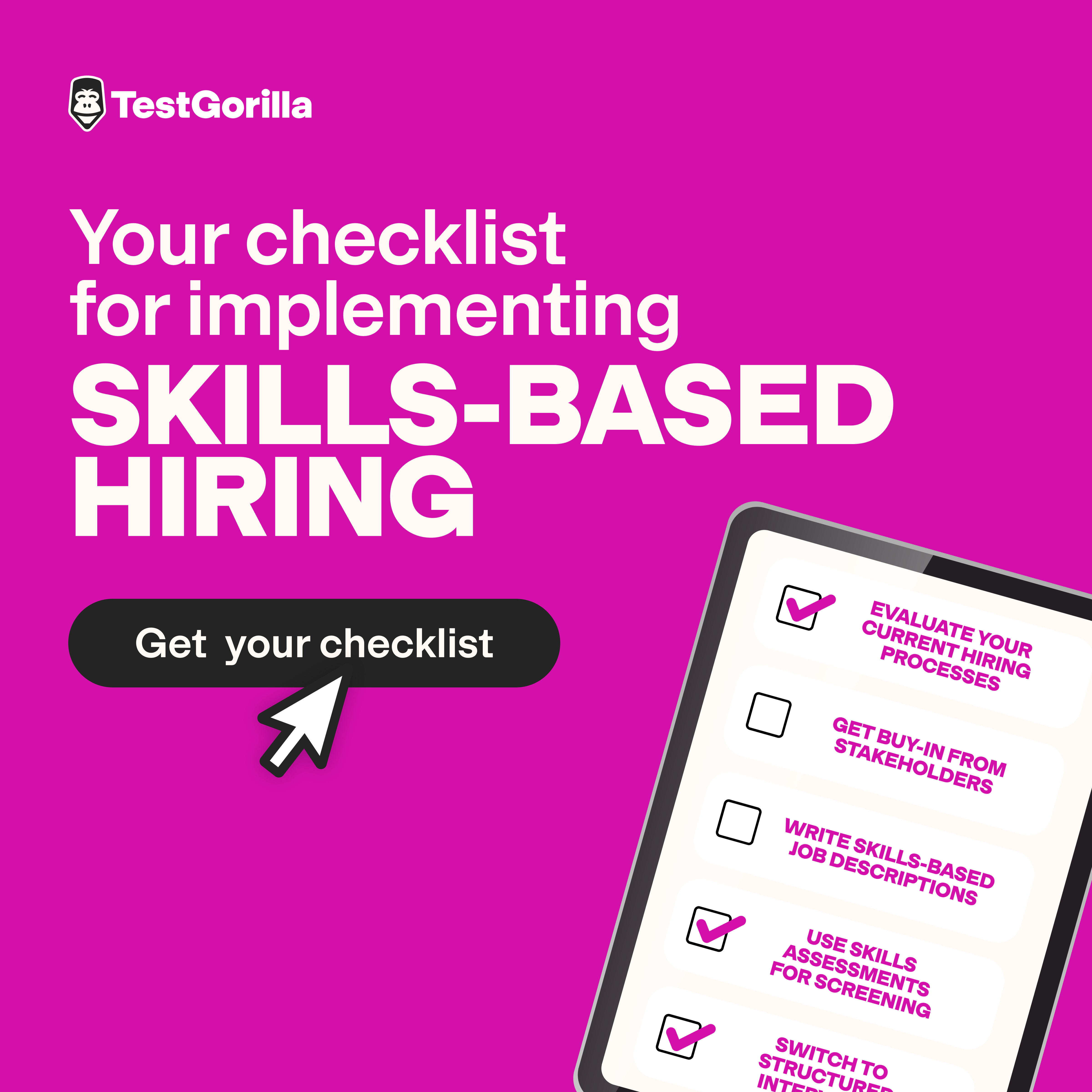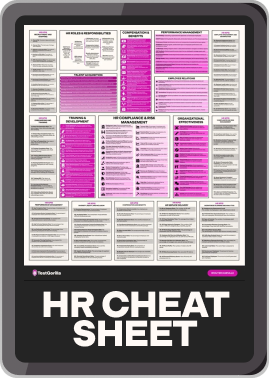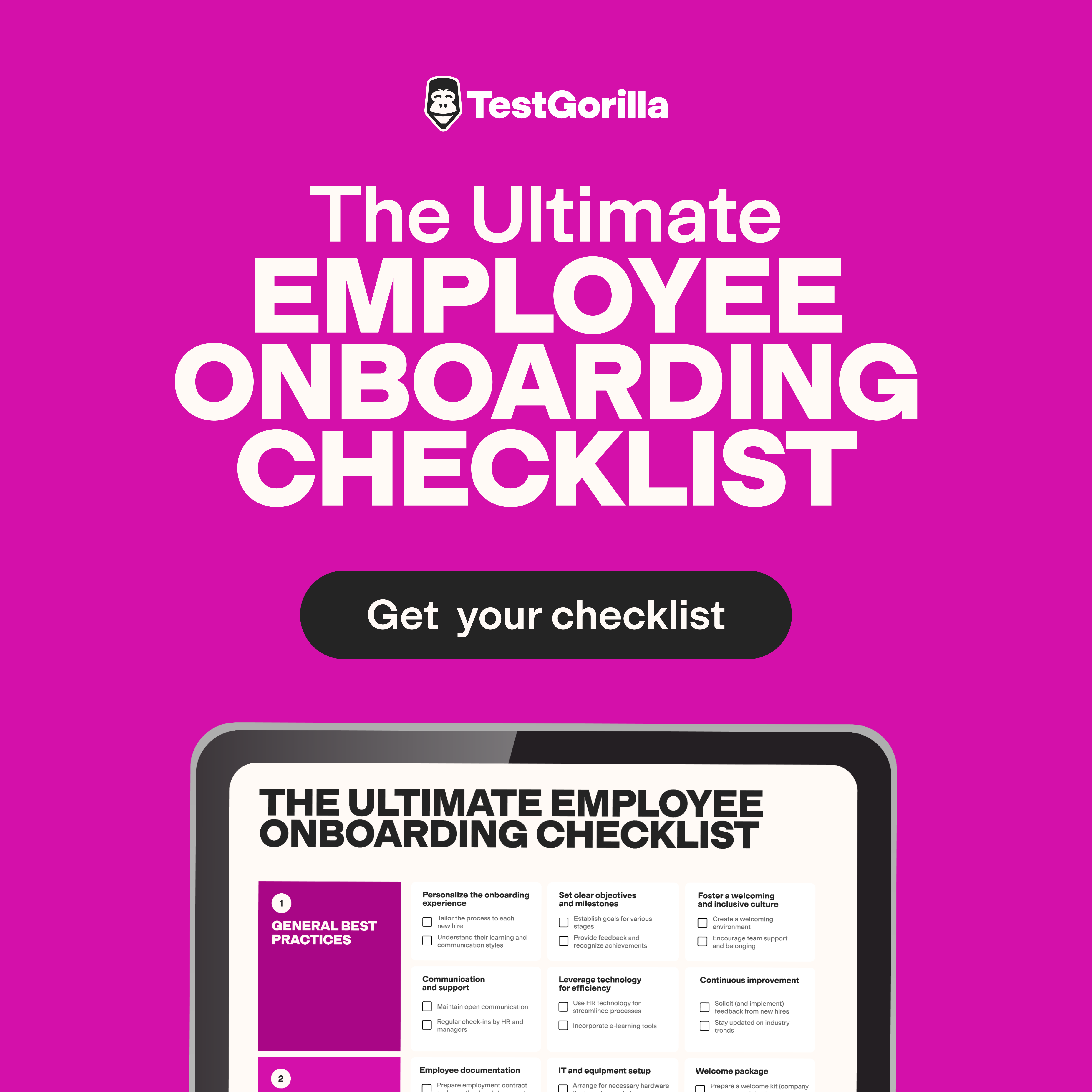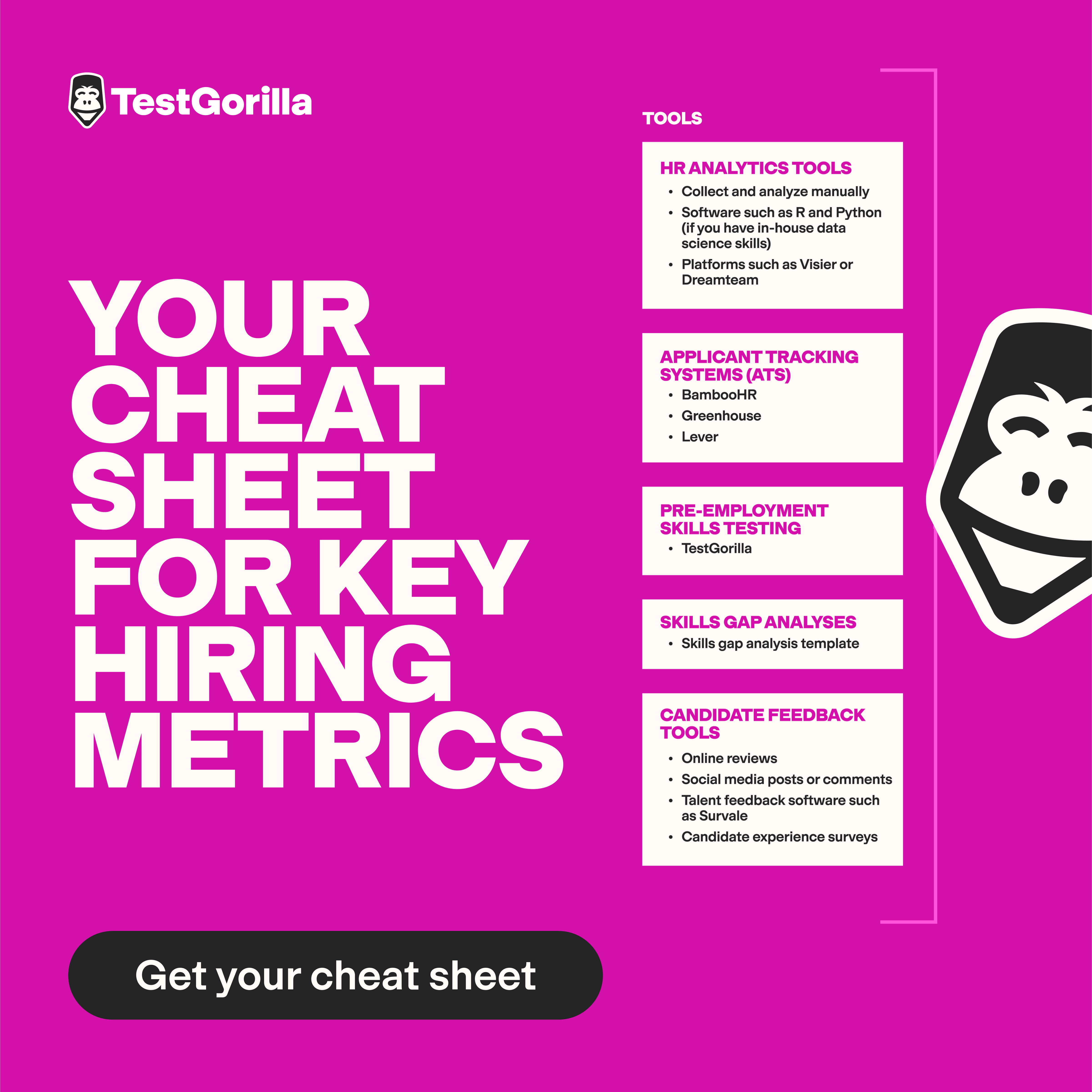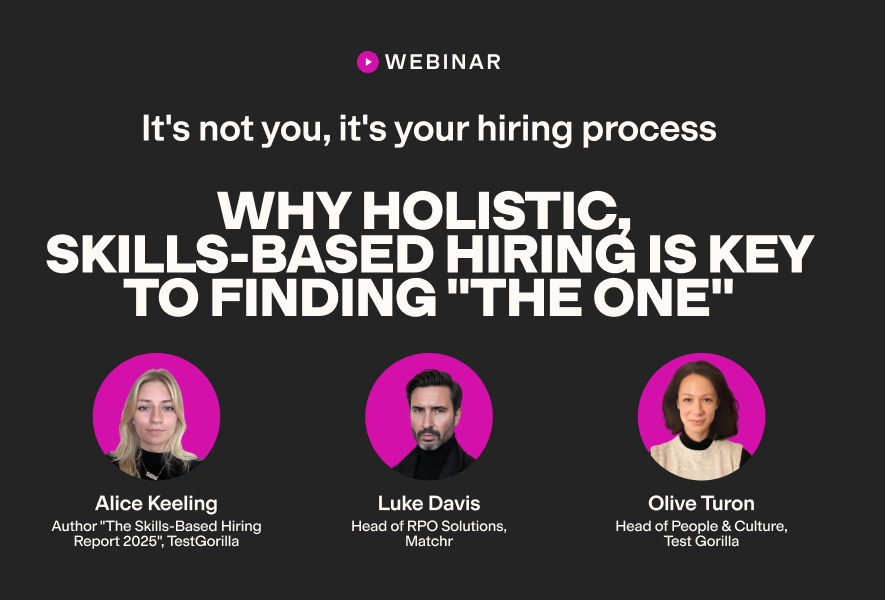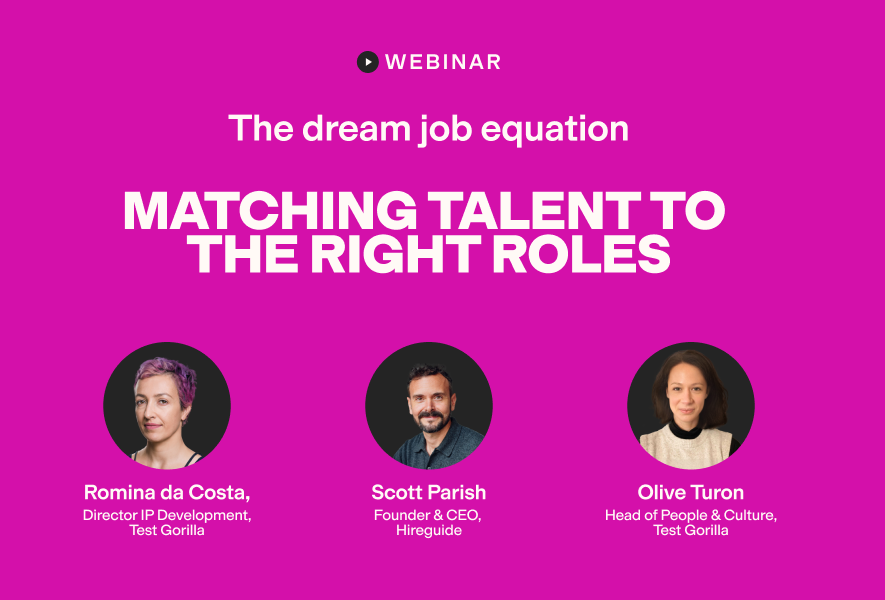How to assess candidate motivation with TestGorilla’s hottest innovation: The Motivation test
Have you hired a candidate with brilliant skills and experience, only to see them underperform later because they weren’t truly motivated for the job?
Unfortunately, many hiring managers have, which is why, when hiring someone, you should be looking for both “skill” and “will”:
But job motivation is incredibly difficult to predict — and there are so few motivation tests on the market.
Good news! At TestGorilla, we’ve developed a Motivation test you can use in recruitment.
Below, we give you more information on employee motivation and its importance in the workplace. We also explain what our Motivation test does and how it can help you hire the most motivated talent.
Table of contents
- Why employee motivation is important
- What is motivation, really?
- How to assess candidate motivation
- What is TestGorilla’s Motivation test – and what makes it unique?
- How does the Motivation test work?
- Free tools to measure candidate motivation
- Using a pre-employment Motivation test helps you predict long-term employee motivation and success
Why employee motivation is important
Employee motivation is the commitment, engagement, enthusiasm, and energy that every employee brings to the workplace. It’s the combination of effort, direction, and persistence that drives employees to pursue goals and succeed.
Highly motivated employees help the whole team excel and achieve its goals consistently, which is why fostering motivation is critical to business success. Some of the benefits of a highly motivated workforce are:
Better employee performance
Improved quality of work
Reduced turnover, absenteeism, and lateness
Improved team morale
What is motivation, really?
To understand how motivated your candidates are, you must be able to distinguish between two different types of job motivation: intrinsic and extrinsic.
Intrinsic motivation
Intrinsic motivation is related to the individual’s behavior and personality traits, as well as their desire to perform well and their willingness to learn new skills, take on new responsibilities, and grow within the company.
Intrinsic motivation comes from within but is also closely connected to the company culture (the company’s values, mission, and vision), as well as to the level of complexity and perceived meaningfulness of the role itself.
If the employee shares the values of the company, they’ll likely feel more motivated at work, which will impact both their performance and their willingness to learn new skills.
Extrinsic motivation
Extrinsic motivation is related to the compensation and benefits your company provides and the specific rewards and recognition you give to your employees.
You can use praise, performance bonuses, a comprehensive healthcare plan, shares in the company, gym subscriptions, flexible work arrangements, paid time off, and more as extrinsic motivational factors.
The best insights on HR and recruitment, delivered to your inbox.
Biweekly updates. No spam. Unsubscribe any time.
How to assess candidate motivation
Personality tests, questions about general job preferences, or interview questions designed to test how motivated candidates were in past situations aren’t reliable predictors of future motivation, as they don’t take into account the specifics of the role itself.
The best way to measure job motivation is with TestGorilla’s Motivation test, a science-backed motivation assessment tool for hiring you can use to effectively and efficiently predict future job motivation across your entire applicant pool.
The results of our Motivation test depend on the characteristics of the job itself – as defined by the employer – rather than on general ideas, principles, or the candidate’s personality. For this reason, our test allows you to identify candidates who’ll be motivated by the specific job for which you’re hiring.
Even better, you can combine it with other tests. Some of these tests can be used to further assess motivation (our Culture Add test assesses whether the candidate’s values align with your company’s – if they do, they’re more likely to feel motivated by the role).
What is TestGorilla’s Motivation test – and what makes it unique?
TestGorilla’s Motivation Test enables you to predict job motivation by comparing what candidates want from a job with what the job actually offers. It’s backed by science – so you can feel confident relying on its results.
The science behind TestGorilla’s Motivation test
The Motivation Test is built on the Job Characteristics Model developed by organizational psychologists Richard Hackman and Greg Oldham. They introduce the model in their article, “Motivation Through the Design of Work: Test of a Theory.” According to this model, the design and nature of a job – including how varied, autonomous, and meaningful it is – significantly influence employee motivation and engagement.
Hackman and Oldham identified three critical psychological states that drive intrinsic motivation:
The experience of meaningfulness in one’s work
A sense of personal responsibility for outcomes
An understanding of the results of one's efforts
When these states are satisfied, employees are more likely to be engaged, committed, and high-performing.
These states are influenced by five core job characteristics:
Skill variety: The range of skills and activities required
Task identity: How much the job involves completing a whole, identifiable piece of work
Task significance: The job’s impact on others
Autonomy: The degree of freedom and independence the job enables
Feedback: How clearly performance outcomes are conveyed
Various studies have shown that the Job Characteristics Model accurately predicts that job characteristics significantly influence intrinsic job satisfaction, including cross-validation studies and meta-analyses.
Even more recent studies continue to show the model’s relevance in today’s diverse and dynamic work environments. For instance, one recent study found that job characteristics like autonomy, skill variety, and task significance are positively associated with employee engagement.
TestGorilla’s Motivation test also incorporates “moderating factors” (or moderators) another concept from the Job Characteristics model. These are factors that influence how strongly an individual responds to the job characteristics. In Hackman and Oldham’s model, the key moderating variable is “growth need strength” – an employee’s desire for personal growth, learning, and challenge. (An example of a moderator from our test is job preferences.)
Interested in learning more about the Job Characteristics Model? Check out TestGorilla’s deep dive into job characteristics and employee motivation.
How does the Motivation test work?
The Motivation test is essentially a two-way test: The employer (you) and the applicant both have a role in it.
The test’s dual-survey approach is as follows:
Employers complete a survey that defines the characteristics of the role – including the degree of autonomy, task variety, feedback, extrinsic factors (like compensation and time off), and core job activities.
Candidates take a parallel survey where they express their preferences and expectations for the same dimensions, such as preferred work conditions, values, and task types.
Here’s a more detailed overview of the dual-survey approach:
What employers do | What candidates do |
First, you create a profile of the role for which you’re hiring. You answer a survey with questions across the four areas that are known to have an impact on motivation: - The degree to which the role includes job characteristics that correlate with the three “critical psychological states” mentioned above - How key “moderators” that may increase or decrease an individual employee’s motivation – such as opportunities for growth, pay, and security – will play out in the role - Extrinsic factors of the role, such as part-time/full-time and the amount of time off - Job activities, which are given in word groups such as “Building – Developing – Architecting” and “Organizing – Classifying – Sorting” (you need to rate these activities on a scale of 0 to 4 based on their importance for the role) We encourage you to be as precise as possible when filling out your part of the survey. If you exaggerate and make the job look more interesting than it really is, you risk having the “wrong” candidates rank the highest. | Candidates receive a parallel version of the survey that addresses the same topics. They: - Answer questions about how important each of these factors is to them - Indicate their preferences, like their desired pay and time off and whether they’d prefer to work part time or full time They see the test as a Job Preferences survey – not a motivation test – which encourages them to express their honest preferences and needs and to indicate the factors that feel the most motivating to them. In the final section of the Motivation test, applicants select 10 work activities they like to spend their time on from the same (blank/unscored) list of job activities you completed. They don’t need to score or rank these activities. |
We map the results of each candidate against your answers in each of these areas. The test measures alignment between what the candidate wants and what the job offers. A higher degree of alignment indicates a stronger motivational fit.
Free tools to measure candidate motivation
TestGorilla’s free candidate motivation test is best combined with our other tests from our test library, like cognitive ability tests, role-specific skills tests, and the Culture Add test. This way, you can get a complete overview of your candidates’:
Role-specific skills
Cognitive abilities
Personality traits
Culture add
Motivation in relation to the role
You can combine up to five tests to create an assessment that you can then send to all candidates as a part of your screening process.
We recommend that you administer the assessment early on in the hiring process in order to evaluate applicants’ skills and motivation, which will help you decide whom to interview. This way, you won’t waste time interviewing candidates whose preferences and motivators don’t align with your offering.
Using a pre-employment Motivation test helps you predict long-term employee motivation and success
The pre-employment Motivation test hands you important information about your candidates’ motivation in relation to the particular role you’re looking to fill. This allows you to select someone who’s likely to stay with the company longer, be driven to excel and grow, and take on new challenges and responsibilities.
By combining this test with other skills assessments, you can identify candidates who are both highly skilled and highly motivated.
Ready to hire candidates who are motivated, engaged, and ready to grow? Sign up for free to try TestGorilla’s free Motivation Test now and start building a team that thrives. You can also book a free demo.
You've scrolled this far
Why not try TestGorilla for free, and see what happens when you put skills first.


